Sites of Japan’s Meiji Industrial Revolution: Iron and Steel, Shipbuilding and Coal Mining
| Sites of Japan’s Meiji Industrial Revolution: Iron and Steel, Shipbuilding and Coal Mining | |
|---|---|
| Name as inscribed on the World Heritage List | |
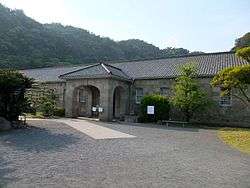 | |
| Type | Cultural |
| Criteria | ii, iii, iv |
| Reference | 1484 |
| UNESCO region | Asia-Pacific |
| Inscription history | |
| Inscription | 2015 (39th Session) |
Sites of Japan’s Meiji Industrial Revolution: Iron and Steel, Shipbuilding and Coal Mining (明治日本の産業革命遺産 製鉄・鉄鋼、造船、石炭産業 Meiji nihon no sangyoukakumeiisan seitetsu tekkou, zousen sekitansangyou) are a grouping of historic sites that played an important part in the industrialization of Japan in the Bakumatsu and Meiji periods, and are part of the industrial heritage of Japan.[1] In 2009 the monuments were submitted jointly for inscription on the UNESCO World Heritage List under criteria ii, iii, and iv. The sites were accepted at the 39th UNESCO World Heritage session.
Eight areas are registered, with thirty component sites:[2][3]
(1) Yamaguchi: Hagi
Hagi proto-industrial sites and Tokugawa period cultural setting; Hagi, Yamaguchi Prefecture:
| Site | Comments | Image |
|---|---|---|
| Hagi reverberatory furnace (萩反射炉 Hagi hansharo)[4][5] | Historic Site | |
| Ebisugahana shipyard (恵美須ヶ鼻造船所跡 Ebisugahana zōsensho ato)[6] | 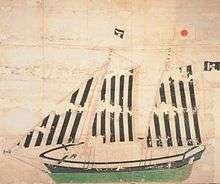 | |
| Ōitayama-tatara iron smelting works (大板山たたら製鉄遺跡 Ōitayama tatara seitetsui ato)[6][7] | Prefectural Historic Site | |
| Shōkasonjuku Academy (松下村塾 Shōkason juku)[8][9] | run by Yoshida Shōin; Historic Site | 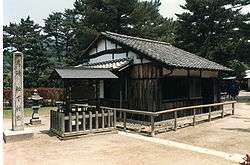 |
| Hagi castle town (萩城下町 Hagi jōkamachi)[10][11] | Historic Site; Groups of Traditional Buildings | 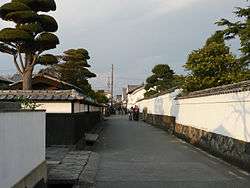 |
(2) Kagoshima: Kagoshima
Shūseikan pioneering factory complex; Kagoshima, Kagoshima Prefecture:
| Site | Comments | Image |
|---|---|---|
| Former Shūseikan (旧集成館 kyū Shūseikan)[12][13] | Historic Site | |
| Shūseikan machine factory (旧集成館機械工場 Shūseikan kikai kōjō)[12][14] | erected in 1865; Important Cultural Property |  |
| Former Kagoshima spinning engineer's residence (旧鹿児島紡績所技師館 kyū Kagoshima hōsekijogishikan)[15][16] | erected in 1867; Important Cultural Property |  |
| Gionnosu Battery (祇園之洲砲台跡 Gionnosu hōdai ato)[17][18] | ||
(3) Saga: Saga
Mietsu shipyard; Saga, Saga Prefecture:
| Site | Comments | Image |
|---|---|---|
| Mietsu naval facility site (三重津海軍所跡 Mietsu kaigunsho ato)[19] | ||
(4) Iwate: Kamaishi
Hashino iron mining and smelting site; Kamaishi, Iwate Prefecture:
| Site | Comments | Image |
|---|---|---|
| Hashino iron mining and smelting site (橋野鉄鉱山および関連施設 Hashino tetsu kōzan oyobi kanren shisetsu)[20][21] | influenced Yawata (see below); Historic Site |  |
(5) Nagasaki: Nagasaki
Nagasaki shipyard facilities, coal mining islands and associated sites; Nagasaki, Nagasaki Prefecture:
| Site | Comments | Image |
|---|---|---|
| Site of Kosuge ship repair dock (小菅修船場跡 Kosuge shūsenba ato)[22][23] | Historic Site | 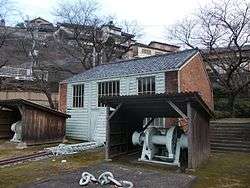 |
| Hokkei well shaft, Takashima coal mine (北渓井坑跡 Hokkei seikō ato)[24][25] | Municipal Historic Site | |
| Hashima coal mine (端島炭坑 Hashima tankō)[25][26] |  | |
| Former Glover House (旧グラバー住宅 kyū Gulabā jūtaku)[27][28] | erected in 1863; Important Cultural Property | 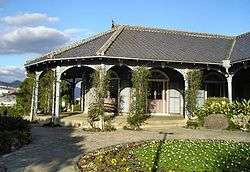 |
| Mitsubishi Nagasaki shipyard (長崎造船所関連施設 Nagasaki zōsenjo kanren shisetsu)[3] | includes Mokojima No.3 dry dock; Scottish-built hammerhead crane (1909);[29] pattern shop; Western-style guest house | 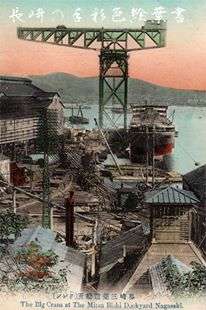 |
(6) Yamaguchi: Shimonoseki
Shimonoseki battle site and Treaty lighthouse; Shimonoseki, Yamaguchi Prefecture:
| Site | Comments | Image |
|---|---|---|
| Maeda Battery (前田砲台跡 Maeda hōdai ato)[30] | .jpg) | |
| Mutsurejima Lighthouse (六連島灯台 Mutsurejima tōdai)[3] |  | |
(7) Fukuoka: Ōmuta; Kumamoto: Arao, Uki
Miike coal mines, railway and ports; Ōmuta, Fukuoka Prefecture, Arao and Uki, Kumamoto Prefecture:
| Site | Comments | Image |
|---|---|---|
| Miyanohara Pit, Miike coal mine (三井石炭鉱業株式会社三池炭鉱宮原坑施設 Mitsui sekitan kōgyō kabushikigaisha, Miike tankō Miyahara ana shisetsu)[31][32] | completed in 1901; Important Cultural Property | |
| Miike port and coal mine industrial railway (三池港・三池炭鉱専用鉄道 Miikekō ・Miike tankō senyō tetsudō)[33] | | |
| Misumi West Port (三角西港 Misumi nishikō)[34][35] | constructed in 1887; Important Cultural Property |  |
(8) Fukuoka: Kitakyūshū
Yawata steel works; Kitakyūshū, Fukuoka Prefecture:
| Site | Comments | Image |
|---|---|---|
| The State-owned Yawata Steel Works (旧官営八幡製鐵所関連施設 kyū kanei Yahata seitetsusho kanren shisetsu)[36] | | |
| Onga River pumping station (遠賀川ポンプ場 Ongagawa ponpujyō)[3] | ||
(9) Shizuoka: Izunokuni
Izu proto-industrial reverberatory furnace; Izunokuni, Shizuoka Prefecture:
| Site | Comments | Image |
|---|---|---|
| Niirayama reverberatory furnace (韮山反射炉 Niirayama hansharo)[37] | Historic Site | 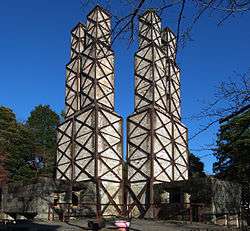 |
Controversy
The inclusion of some of these properties as UNESCO Heritage sites faced concerns and objections from Korea, due to the fact that conscripted Korean civilians and Chinese prisoners-of-war were forced to work under harsh conditions at seven of these sites during Japan's World War II mobilization policies. See Hashima_Island#World_Heritage_Site_approval_controversy for more details.
See also
References
- ↑ "Sites of Japan's Meiji Industrial Revolution: Iron and Steel, Shipbuilding and Coal Mining". UNESCO. Retrieved 5 July 2015.
- ↑ "To be World Heritage: Updated Situation". Kyuyama. Retrieved 17 February 2012.
- 1 2 3 4 "Emergence of Industrial Japan: Kyushu - Yamaguchi" (PDF). Kyuyama. Retrieved 17 February 2012.
- ↑ "Hagi Reverberatory Furnace". Kyuyama. Retrieved 17 February 2012.
- ↑ "萩反射炉". Agency for Cultural Affairs. Retrieved 17 February 2012.
- 1 2 "Ebisugahana shipyard & Ohitayama-Tatara iron smelting works". Kyuyama. Retrieved 17 February 2012.
- ↑ "大板山たたら製鉄遺跡". Yamaguchi Prefecture. Retrieved 17 February 2012.
- ↑ "The Shokasonjuku Academy". Kyuyama. Retrieved 17 February 2012.
- ↑ "松下村塾". Agency for Cultural Affairs. Retrieved 17 February 2012.
- ↑ "Hagi Castle Town". Kyuyama. Retrieved 17 February 2012.
- ↑ "萩城城下町". Agency for Cultural Affairs. Retrieved 17 February 2012.
- 1 2 "Former Shūseikan and machine factory". Kyuyama. Retrieved 17 February 2012.
- ↑ "旧集成館". Agency for Cultural Affairs. Retrieved 17 February 2012.
- ↑ "旧集成館機械工場". Agency for Cultural Affairs. Retrieved 17 February 2012.
- ↑ "Former Kagoshima Spinning Engineer's Residence". Kyuyama. Retrieved 17 February 2012.
- ↑ "旧鹿児島紡績所技師館". Agency for Cultural Affairs. Retrieved 17 February 2012.
- ↑ "Gionnosu Battery". Kyuyama. Retrieved 17 February 2012.
- ↑ "祇園之洲砲台跡". Kagoshima City. Retrieved 17 February 2012.
- ↑ "Mietsu naval facility site". Kyuyama. Retrieved 17 February 2012.
- ↑ "Hashino Iron Mining and Smelting Site". Kyuyama. Retrieved 17 February 2012.
- ↑ "橋野高炉跡". Agency for Cultural Affairs. Retrieved 17 February 2012.
- ↑ "Site of Kosuge ship repair dock". Kyuyama. Retrieved 17 February 2012.
- ↑ "小菅修船場跡". Agency for Cultural Affairs. Retrieved 17 February 2012.
- ↑ "Hokkei well shaft, Takashima coal mine". Kyuyama. Retrieved 17 February 2012.
- 1 2 "北渓井坑跡". Nagasaki City. Retrieved 17 February 2012.
- ↑ "Hashima coal mine". Kyuyama. Retrieved 17 February 2012.
- ↑ "Former Glover House". Kyuyama. Retrieved 17 February 2012.
- ↑ "旧グラバー住宅(長崎県長崎市南山手町)". Agency for Cultural Affairs. Retrieved 17 February 2012.
- ↑ "三菱重工業長崎造船所ハンマーヘッド型起重機". Agency for Cultural Affairs. Retrieved 17 February 2012.
- ↑ "Maeda Battery". Kyuyama. Retrieved 17 February 2012.
- ↑ "Miyanohara Pit, Miike coal mine". Kyuyama. Retrieved 17 February 2012.
- ↑ "三井石炭鉱業株式会社三池炭鉱宮原坑施設". Agency for Cultural Affairs. Retrieved 17 February 2012.
- ↑ "Miike Port and Coal Mine Industrial Railway". Kyuyama. Retrieved 17 February 2012.
- ↑ "Misumi West Port". Kyuyama. Retrieved 17 February 2012.
- ↑ "三角旧港(三角西港)施設". Agency for Cultural Affairs. Retrieved 17 February 2012.
- ↑ "The State-owned Yawata Steel Works". Kyuyama. Retrieved 17 February 2012.
- ↑ "Sites of Japan's Meiji Industrial Revolution: Iron and Steel, Shipbuilding and Coal Mining". UNESCO. Retrieved 21 October 2015.
External links
- UNESCO Tentative List entry
- The Modern Industrial Heritage Sites in Kyushu and Yamaguchi
- Emergence of Industrial Japan: Kyushu and Yamaguchi
- The Modern Industrial Heritage Sites in Kyushu and Yamaguchi (Japanese)